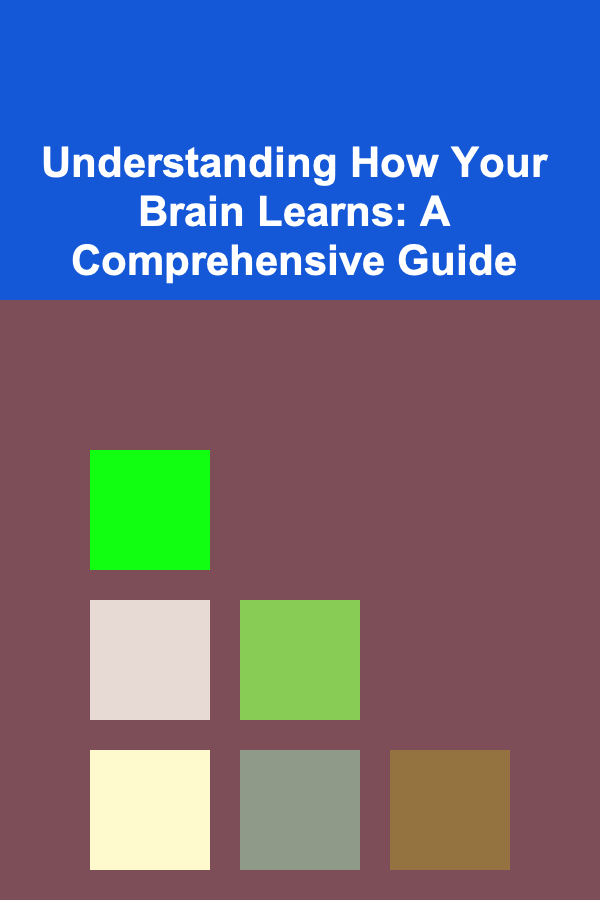
Understanding How Your Brain Learns: A Comprehensive Guide
ebook include PDF & Audio bundle (Micro Guide)
$12.99$7.99
Limited Time Offer! Order within the next:

Introduction: Unlocking the Secrets of Neural Plasticity
Learning, the cornerstone of human progress, is fundamentally a biological process happening within the intricate landscape of the brain. It's not just about memorizing facts or acquiring skills; it's about the brain's remarkable ability to adapt, rewire, and reorganize itself in response to new experiences, information, and stimuli. This adaptability, known as neural plasticity or brain plasticity, is the key to understanding how learning truly works. To effectively enhance our learning capabilities, it's crucial to delve into the underlying mechanisms of how our brains absorb, process, and retain information.
This exploration will venture beyond simple memorization techniques and delve into the neuroscience behind learning. We'll uncover the roles of various brain regions, the intricate dance of neurotransmitters, and the importance of factors like sleep, nutrition, and emotional state. By understanding these fundamental aspects, we can unlock personalized strategies to optimize our learning potential and achieve our cognitive goals.
The Biological Foundation of Learning: Neurons, Synapses, and Networks
At the heart of learning lies the neuron , the fundamental building block of the nervous system. Neurons communicate with each other through specialized junctions called synapses. Learning fundamentally changes the strength and efficiency of these synaptic connections.
Synaptic Plasticity: Strengthening and Weakening Connections
Synaptic plasticity refers to the brain's capacity to modify the strength of synaptic connections between neurons. This modification, whether strengthening or weakening, is believed to be the fundamental cellular mechanism underlying learning and memory. Two prominent forms of synaptic plasticity are:
- Long-Term Potentiation (LTP): LTP involves the strengthening of synaptic connections, making it easier for neurons to communicate with each other in the future. This strengthening is often associated with increased frequency of neuronal firing and the formation of stronger, more reliable pathways. Think of it like forging a well-trodden path through a forest -- the more you use it, the easier it becomes to navigate.
- Long-Term Depression (LTD): LTD, conversely, involves the weakening of synaptic connections. This process is important for pruning unnecessary or redundant connections, allowing the brain to refine its circuitry and focus on relevant information. Imagine weeding a garden -- removing the unwanted plants allows the desired ones to flourish.
The interplay between LTP and LTD is crucial for learning. LTP strengthens pathways associated with new information and skills, while LTD weakens pathways that are no longer relevant or useful. This dynamic process allows the brain to sculpt its neural networks in response to experience.
Neurotransmitters: Chemical Messengers of Learning
Neurotransmitters are chemical messengers that transmit signals between neurons across the synapse. Several neurotransmitters play critical roles in learning and memory. Key examples include:
- Glutamate: The primary excitatory neurotransmitter in the brain, glutamate is crucial for LTP and LTD. Receptors like NMDA receptors are vital for initiating synaptic changes associated with learning.
- Dopamine: Dopamine is involved in reward, motivation, and reinforcement learning. It helps the brain associate actions with positive outcomes, making it more likely that those actions will be repeated. Think of the rewarding feeling of mastering a new skill -- dopamine plays a central role in this.
- Acetylcholine: Acetylcholine is involved in attention, memory, and arousal. It plays a crucial role in encoding new memories and retrieving existing ones.
The balance of these neurotransmitters is essential for optimal learning. Disruptions in neurotransmitter levels can impair cognitive function and learning ability.
Brain Networks: Orchestrating Complex Cognitive Functions
Learning isn't a localized process; it involves the coordinated activity of multiple brain regions working together in complex neural networks. These networks are responsible for various cognitive functions, including attention, memory, language, and executive function. Some key brain networks involved in learning include:
- The Default Mode Network (DMN): While often associated with mind-wandering, the DMN also plays a role in consolidating memories and reflecting on past experiences, which is essential for learning from mistakes and integrating new information into existing knowledge.
- The Central Executive Network (CEN): The CEN is responsible for cognitive control, attention, and working memory. It helps us focus on relevant information and filter out distractions, which is crucial for effective learning.
- The Salience Network (SN): The SN identifies and prioritizes important stimuli, helping us focus our attention on what matters most. This is crucial for deciding what information to learn and what to ignore.
Understanding how these networks interact is essential for understanding the broader cognitive processes involved in learning. Damage or dysfunction in these networks can significantly impair learning ability.
Brain Regions Involved in Learning and Memory
Different brain regions specialize in different types of learning and memory. Understanding the roles of these regions can provide valuable insights into how we learn and remember.
The Hippocampus: The Memory Maker
The hippocampus is crucial for the formation of new declarative memories, which are memories of facts and events. It acts like a temporary storage buffer, consolidating memories before they are transferred to other brain regions for long-term storage. Damage to the hippocampus can result in anterograde amnesia, the inability to form new long-term memories.
Spatial learning, the ability to navigate and remember locations, is also heavily dependent on the hippocampus. Studies have shown that London taxi drivers, who have extensive knowledge of the city's streets, have larger hippocampi than average individuals.
The Amygdala: The Emotional Center
The amygdala plays a critical role in processing emotions, particularly fear and anxiety. It is also involved in emotional learning, where we learn to associate certain stimuli or experiences with emotional responses. For example, the amygdala is responsible for the conditioned fear response, where we learn to fear a previously neutral stimulus after it has been paired with a negative experience.
The amygdala's influence on learning extends beyond fear. Emotional experiences, in general, tend to be more memorable than neutral ones. This is because the amygdala modulates the activity of other brain regions involved in memory, enhancing the encoding and retrieval of emotionally charged information.
The Cerebellum: The Skill Builder
The cerebellum is primarily involved in motor learning and the acquisition of skills that require precise movements. This includes activities like riding a bike, playing a musical instrument, and typing. The cerebellum helps coordinate movements, refine motor skills, and automate well-learned motor sequences.
The cerebellum also plays a role in procedural memory, which is the memory of how to do things. Unlike declarative memory, procedural memory is often implicit and unconscious. We can perform a skill without consciously remembering the steps involved. The cerebellum, in conjunction with the basal ganglia, is critical for the development of these automatic skills.
The Prefrontal Cortex: The Executive Function Hub
The prefrontal cortex (PFC) is the brain's control center, responsible for executive functions like planning, decision-making, working memory, and cognitive flexibility. It plays a crucial role in goal-directed learning and the ability to adapt to changing circumstances. The PFC allows us to consciously control our learning process, focus our attention, and monitor our progress.
The PFC is particularly important for working memory, which is the ability to hold information in mind and manipulate it. Working memory is essential for complex cognitive tasks like problem-solving, reasoning, and language comprehension. A strong working memory capacity is a significant predictor of academic success.
Factors Influencing Learning: Beyond the Biology
While understanding the neurobiological mechanisms of learning is crucial, several external and internal factors can significantly influence our learning ability.
Sleep: The Brain's Consolidation Tool
Sleep is essential for learning and memory consolidation. During sleep, the brain replays and strengthens newly formed memories, transferring them from the hippocampus to the neocortex for long-term storage. Sleep deprivation impairs learning and memory performance, making it difficult to encode new information and retrieve existing memories.
Different stages of sleep play different roles in memory consolidation. Slow-wave sleep (SWS) is particularly important for consolidating declarative memories, while rapid eye movement (REM) sleep is important for consolidating procedural memories and emotional memories.
Prioritizing sleep is one of the most effective strategies for enhancing learning. Aim for 7-9 hours of quality sleep each night.
Nutrition: Fueling the Brain
Nutrition plays a vital role in brain health and cognitive function. A balanced diet that provides essential nutrients is crucial for optimal learning. Specific nutrients that are particularly important for brain function include:
- Omega-3 fatty acids: Essential for brain cell structure and function, found in fatty fish, flaxseeds, and walnuts.
- Antioxidants: Protect brain cells from damage caused by free radicals, found in fruits, vegetables, and berries.
- B vitamins: Involved in energy production and neurotransmitter synthesis, found in whole grains, lean meats, and leafy green vegetables.
Avoid processed foods, sugary drinks, and excessive amounts of saturated and unhealthy fats, as these can negatively impact brain function. Staying hydrated by drinking plenty of water is also crucial for maintaining cognitive performance.
Stress and Anxiety: Impeding Learning
Stress and anxiety can significantly impair learning and memory. Chronic stress releases cortisol, a stress hormone that can damage brain cells and interfere with synaptic plasticity. High levels of anxiety can also distract from learning, making it difficult to focus and concentrate.
Stress management techniques, such as mindfulness meditation, yoga, and deep breathing exercises, can help reduce stress and improve learning. Creating a supportive and relaxed learning environment can also help alleviate anxiety.
Motivation and Engagement: Igniting the Learning Fire
Motivation and engagement are essential for effective learning. When we are intrinsically motivated to learn something, we are more likely to pay attention, process information deeply, and retain it for longer. Finding ways to make learning enjoyable and relevant can significantly enhance motivation.
Setting clear goals, breaking down tasks into manageable steps, and providing positive reinforcement can also help boost motivation. Creating a sense of curiosity and exploration can make learning more engaging and rewarding.
Environment: Creating an Optimal Learning Space
The environment in which we learn can also impact our learning ability. A quiet, well-lit, and organized space can help minimize distractions and promote focus. Personalizing the learning environment to suit individual preferences can also enhance comfort and engagement.
Consider factors such as temperature, noise levels, and visual stimuli when designing a learning space. Experiment with different settings to find what works best for you.
Strategies to Optimize Learning: A Practical Toolkit
Based on the principles discussed above, here are some practical strategies to optimize your learning:
Active Recall: Testing Your Knowledge
Active recall involves actively retrieving information from memory rather than passively rereading or reviewing it. This technique strengthens memory traces and improves long-term retention. Techniques include:
- Flashcards: Create flashcards with questions on one side and answers on the other. Test yourself regularly, focusing on the cards you struggle with.
- Self-testing: After reading a chapter or attending a lecture, try to recall the key concepts and explain them in your own words.
- Practice questions: Solve practice problems or answer questions related to the material you are learning.
Spaced Repetition: Timing is Everything
Spaced repetition involves reviewing information at increasing intervals over time. This technique leverages the forgetting curve, which shows that we tend to forget information rapidly after learning it. By reviewing information just before we are about to forget it, we can strengthen memory traces and improve long-term retention.
- Spaced Repetition Systems (SRS): Use software programs like Anki to schedule reviews based on your performance.
- Review schedules: Create a review schedule that spaces out your reviews over time.
Interleaving: Mixing it Up
Interleaving involves mixing different topics or subjects together during learning, rather than studying them in separate blocks. This technique forces the brain to actively discriminate between different concepts and retrieve relevant information from memory. While it might feel more challenging initially, it can lead to better long-term learning.
- Mix practice problems: Instead of solving practice problems for a single topic in a row, mix problems from different topics together.
- Alternate study sessions: Alternate study sessions between different subjects.
Elaboration: Connecting New Information to Existing Knowledge
Elaboration involves connecting new information to existing knowledge by explaining it in your own words, creating analogies, and drawing connections to personal experiences. This technique helps create richer and more meaningful memory representations.
- Explain to others: Teach the material to someone else, even if it's just a friend or family member.
- Create analogies: Relate new concepts to familiar examples or analogies.
- Connect to personal experiences: Relate new information to your own personal experiences and memories.
Mind Mapping: Visualizing Connections
Mind mapping is a visual technique for organizing and representing information. Start with a central topic or concept and branch out with related ideas, keywords, and images. This technique helps create a visual representation of the relationships between different concepts and can improve understanding and memory.
Chunking: Breaking Down Complex Information
Chunking involves breaking down complex information into smaller, more manageable units. This technique reduces the cognitive load on working memory and makes it easier to process and remember information. For example, instead of trying to memorize a long string of numbers, break it down into smaller groups of digits.
Metacognition: Thinking About Thinking
Metacognition is the awareness and understanding of your own cognitive processes. It involves reflecting on your learning strategies, identifying your strengths and weaknesses, and adjusting your approach accordingly. By becoming more aware of how you learn, you can become a more effective learner.
- Reflect on your learning: After each study session, take some time to reflect on what you learned, what you struggled with, and what you could do differently next time.
- Experiment with different strategies: Try out different learning techniques and strategies to find what works best for you.
- Seek feedback: Ask for feedback from teachers, mentors, or peers on your learning strategies and progress.
Personalized Learning: Tailoring Strategies to Your Unique Brain
While general learning principles apply to everyone, individual differences in brain structure, cognitive abilities, and learning styles can influence how effectively different strategies work. Experimentation and self-awareness are key to finding what works best for you. Consider the following:
- Identify your learning style: Are you a visual, auditory, or kinesthetic learner? While learning styles are a somewhat controversial topic, considering your preferences can still be helpful.
- Assess your strengths and weaknesses: Are you good at memorizing facts but struggle with problem-solving? Focus on developing strategies that address your weaknesses and leverage your strengths.
- Track your progress: Monitor your learning progress and adjust your strategies as needed. Don't be afraid to experiment and try new things.
The field of neuroscience is constantly evolving, providing new insights into how the brain learns. Staying informed about the latest research can help you refine your learning strategies and optimize your cognitive performance.
In conclusion, understanding how your brain learns is a journey of self-discovery and continuous improvement. By grasping the underlying neurobiological mechanisms and experimenting with various learning strategies, you can unlock your cognitive potential and become a more effective and lifelong learner. Remember that learning is a dynamic process, and the more you understand your own brain, the better equipped you will be to adapt, grow, and thrive in an ever-changing world.

Digital Brand Identity: Strategies and Tactics to Create Memorable Brand Experiences Through Design
Read More
How to Create a Checklist for Managing Book Club Budget
Read More
How to Make Your Home Security System More Reliable
Read More
How to Use a Home Safe to Protect Valuables
Read More
How to Use Bulletin Boards for Volunteer Updates
Read More
How To Understand the History of Coffee Consumption
Read MoreOther Products

Digital Brand Identity: Strategies and Tactics to Create Memorable Brand Experiences Through Design
Read More
How to Create a Checklist for Managing Book Club Budget
Read More
How to Make Your Home Security System More Reliable
Read More
How to Use a Home Safe to Protect Valuables
Read More
How to Use Bulletin Boards for Volunteer Updates
Read More